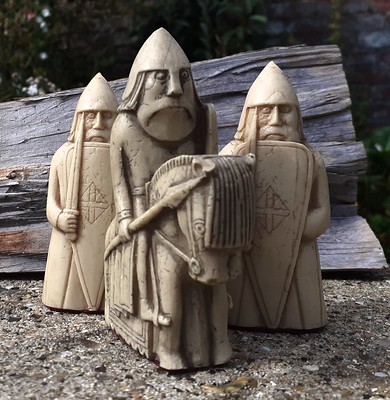A Knight and Two Berserkers
The missing subtitle 'Everybody Loves the Lewis Pieces' recalls the recent post Everybody Loves Morphy (June 2024). Our previous Flickr post featuring the dour little warriors was The Lewis Pieces at Church (May 2023; 'Christ Church Cathedral, Waterford, Ireland').

Lewis Chessmen
© Flickr user Hornbeam Arts under
Creative Commons.
The Flickr description said only,
In the early Welsh story "The Dream of Rhonabwy", Arthur is seen playing a game similar to chess.
The famous pieces even have their own Wikipedia page, Game pieces of the Lewis chessmen hoard (wikipedia.org). The page informs,
The style of carving, particularly that on the thrones of the seated figures, suggests they are Scandinavian in origin, most likely from Trondheim, the medieval capital of Norway until 1217. The types of piece are similar to those in modern chess -- the chessmen are the earliest found that have figures in clerical dress (bishops).
The Rooks are represented as warriors which came to be called "warders" at an early stage after they were discovered. Four of the warders are shown biting their shields -- these have been identified as the berserkers of the Norse sagas. Christian and pagan influences are both present in the designs.
So technically speaking, the two pieces behind the Knight in our Flickr photo aren't berserkers, because they're not biting their shields. Maybe their teeth fell out during previous bites.
As for the dream referenced in the photo description, Wikipedia offers another page, The Dream of Rhonabwy (wikipedia.org; Welsh). Here the 'chess' game is identified as gwyddbwyll, a name that could easily be extraterrestrial in origin, but is in fact 'a Celtic board game similar to Roman ludus latrunculorum'. That reminds me of The Circular Chess Boards of the Druids (April 2024). There we learned,
(Q:) What exactly is a Druid? (A:) 'A druid was a member of the high-ranking priestly class in ancient Celtic cultures.'
So Druids played gwyddbwyll and were probably experts at it.
***
Later: A few weeks after the date on the post, I noticed in Key decisions from the 2024 FIDE General Assembly (chessbase.com) another Lewis reference:-
Gunnar Bjornsson, president of the Icelandic Chess Federation, presented the application from the Greenlandic Chess Federation, which applied to become an Affiliated Member of FIDE. "Chess, while very new in its organized form, has a surprisingly long connection to Greenland. The famous Lewis chessmen, a collection of medieval chess pieces, have been definitively proven to be crafted from walrus tusks of Greenlandic origin," read in the application.
This squares with the Wikipedia page on the Lewis pieces, which says, 'Material: Walrus ivory and whale tooth'.




No comments:
Post a Comment